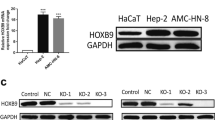Abstract
Objective
The aim of our study was to investigate the effect of Pin1 on the expression of MMP-2 and MMP-9 in human colorectal carcinoma SW620 cells.
Methods
We constructed a eukaryotic expression vector of RNA interfering (shRNA) for Pin1 gene (pGenesil-1-Pin1), and then observed its expression in SW620 cells by Western blotting. The cells motility were tested by wound healing assay and Boyden chamber assay. The protein levels and activity of MMP-2 and MMP-9 were tested by Western blotting and Gelatin zymography in SW620 cells after transfected with pGenesil-1-PIN1.
Results
pGenesil-1-PIN1 was successfully constructed, which was confirmed by sequencing. Silencing the Pin1 by RNAi significantly decreased the cells motility from 96.4 ± 3.9 per field (× 10 objective) to 52.7 ± 4.4 per field (P < 0.05, Student’s t-test) for SW620 cells transfected with pGenesil-1-PIN1 (SW620/p-shRNA) in Boyden chamber assay, and reduced the MMP-2 and MMP-9 expressions and activity in SW620 cells. The protein relative levels of MMP-2 were 0.32 ± 0.04 for SW620/p-shRNA, and 0.76 ± 0.03 for SW620/p-Con; MMP-9 were 0.41 ± 0.09 for SW620/p-shRNA, and 0.94 ± 0.07 for SW620/p-Con (P < 0.05).
Conclusion
Inhibited Pin1 expression may contribute to the suppression of the invasive and metastatic capacity of colon cancer cells in vitro.
Similar content being viewed by others
References
Rippmann JF, Hobbie S, Daiber C, et al. Phosphorylation-dependent proline isomerization catalyzed by Pin1 is essential for tumor cell survival and entry into mitosis. Cell Growth Differ, 2000, 11: 409–416.
Ranganathan R, Lu KP, Hunter T, et al. Structural and functional analysis of the mitotic rotamase Pin1 suggests substrate recognition is phosphorylation dependent. Cell, 1997, 89: 876–886.
Bao L, Kimzey A, Sauter G, et al. Prevalent overexpression of prolyl isomerase Pin1 in human cancers. Am J Pathol, 2004, 164: 1727–1737.
Mantovani F, Tocco F, Girardini J, et al. The prolyl isomerase Pin1 orchestrates p53 acetylation and dissociation from the apoptosis inhibitor iASPP. Nat Struct Mol Biol, 2007, 14: 912–920.
Yeh ES, Lew BO, Means AR. The loss of PIN1 deregulates cyclin E and sensitizes mouse embryo fibroblasts to genomic instability. J Biol Chem, 2006, 281: 241–251.
Liu J, Zhao J, Yang JM. The expression of Pin1, β-catenin and cyclin D1 in elderly lung carcinomas and their significance. Chinese-German J Clin Oncol, 2008, 7: 379–382.
Xu YX, Manley JL. The prolyl isomerase Pin1 functions in mitotic chromosome condensation. Mol Cell, 2007, 26: 287–300.
Couzin J. Breakthrough of the year. Small RNAs make big splah. Science, 2002, 298: 2296–2297.
Bosher JM, Labouesse M. RNA interference: genetic wand and genetic wand and genetic watchdog. Nat Cell Biol, 2002, 2: E31–36.
Elbashir SM, Lendeckel W, Tuschl T. RNA interference is mediated by 21- and 22-nucleotide RNAs. Genes Dev, 2001, 15: 188–200.
Fire A, Xu S, Montgomery MK, et al. Potent and specific genetic interference by double-stranded RNA in Caenorhabditis elegans. Nature, 1998, 391: 806–811.
Lippens G, Landrieu I, Smet C. Molecular mechanisms of the phospho- dependent prolyl cis/trans isomerase Pin1. FEBS J, 2007, 274: 5211–5222.
Takahashi Y, Kawahara F, Noguchi M, et al. Activation of matrix metalloproteinase-2 in human breast cancer cells overexpressing cyclooxygenase-1 or -2. FEBS Lett, 1999, 460: 145–148.
Sivula A, Talvensaari-Mattila A, Lundin J, et al. Association of cyclooxygenase-2 and matrix metalloproteinase-2 expression in human breast cancer. Breast Cancer Res Treat, 2005, 89: 215–220.
Brooks PC, Stromblad S, Sanders LC, et al. Localization of matrix metalloproteinase MMP-2 to the surface of invasive cells by interaction with integrin alpha v beta 3. Cell, 1996, 85: 683–693.
Dohadwala M, Batra RK, Luo, J, et al. Autocrine/paracrine prostaglandin E2 production by non-small cell lung cancer cells regulates matrix metalloproteinase-2 and CD44 in cyclooxygenase-2-dependentin-vasion. J Biol Chem, 2002, 277: 50828–50833.
Han C, Wu T. Cyclooxygenase-2-derived prostaglandin E2 promotes human cholangiocarcinoma cell growth and invasion through EP1 receptor-mediated activation of the epidermal growth factor receptor and Akt. J Biol Chem, 2005, 280: 24053–24063.
Yu Q, Stamenkovic I. Localization of matrix metalloproteinase 9 to the cell surface provides a mechanism for CD44-mediated tumor invasion. Genes Dev, 1999, 13: 35–48.
Author information
Authors and Affiliations
Corresponding author
Additional information
Supported by a grant from the Science and Technology Project of Shanxi Province, China (No. 2006031087-02).
Rights and permissions
About this article
Cite this article
Qin, L., Hao, H., Li, M. et al. Decreasing Pin1 suppressed the properties of migratory and invasive in colorectal carcinoma SW620 cells. Chin. -Ger. J. Clin. Oncol. 9, 216–220 (2010). https://doi.org/10.1007/s10330-010-0013-y
Received:
Revised:
Accepted:
Published:
Issue Date:
DOI: https://doi.org/10.1007/s10330-010-0013-y




